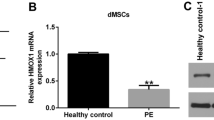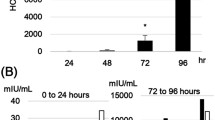Abstract
Trophoblast cells are often compared to highly invasive carcinoma cells due to their capacity to proliferate in hypoxic conditions and to exhibit analogous vascular, proliferative, migratory, and invasive capacities. Thus, genes that are important for tumorigenesis, such as forkhead box M1 (FOXM1) may also be involved in processes of trophoblast invasion. Indeed, we found Foxm1 protein and messenger RNA (mRNA) levels decreased as gestational age increased in rat’s placentae. Accordingly, when mimicking early placental events in vitro, protein and mRNA expression of FOXM1 increased from 21% to 8% O2, reaching its highest expression at 3% oxygen tension, which reflects early implantation environment, and dropping to very low levels at 1% O2. Remarkably, FOXM1 silencing in JEG-3 cells was able to significantly decrease migration by 27.9%, in comparison with those cells transfected with control siRNA. Moreover, angiogenesis was compromised when conditioned media (CM) from FOXM1-siRNA -JEG-3 (3% O2) was added to human umbilical vein endothelial cells (HUVEC) cells; however, when CM of JEG-3 cells overexpressing FOXM1 at 1% O2 was added, the ability of HUVEC to form tubule networks was restored. Additionally, quantitative real-time polymerase chain reaction (PCR) assays of FOXM1 knockdown and overexpression experiments in JEG-3 cells revealed that the depletion of FOXM1 at 3% O2 and overexpression of FOXM1 at 1% O2 led to downregulation and upregulation of vascular endothelial growth factor transcriptional (VEGF) levels, respectively. Conversely, we also observed deregulation of FOXM1 in placentae derived from pregnancies complicated by preeclampsia (PE). Therefore, we demonstrate that FOXM1 may be a new regulatory protein of early placentation processes and that under chronic hypoxic conditions (1% O2) and in patients with severe PE, its levels decrease.
Similar content being viewed by others
References
Hutcheon JA, Lisonkova S, Joseph KS. Epidemiology of pre-eclampsia and the other hypertensive disorders of pregnancy. Best Pract Res Clin Obstet Gynaecol. 2011;25(4):391–403.
Chaiworapongsa T, Chaemsaithong P, Yeo L, Romero R. Pre-eclampsia part 1: current understanding of its pathophysiology. Nat Rev Nephrol. 2014;10(8):466–480.
Bellamy L, Casas JP, Hingorani AD, Williams DJ. Pre-eclampsia and risk of cardiovascular disease and cancer in later life: systematic review and meta-analysis. BMJ. 2007;335(7627):974.
Duley L. The global impact of pre-eclampsia and eclampsia. Semin Perinatol. 2009;33(3):130–137.
Ferretti C, Bruni L, Dangles-Marie V, Pecking AP, Bellet D. Molecular circuits shared by placental and cancer cells, and their implications in the proliferative, invasive and migratory capacities of trophoblasts. Hum Reprod Update. 2007;13(2):121–141.
Koo CY, Muir KW, Lam EW. FOXM1: From cancer initiation to progression and treatment. Biochimica et biophysica acta. 2012;1819(1):28–37.
Wierstra I. The transcription factor FOXM1 (Forkhead box M1): proliferation-specific expression, transcription factor function, target genes, mouse models, and normal biological roles. Adv Cancer Res. 2013;118:97–398.
Bella L, Zona S, Nestal de Moraes G, Lam EW. FOXM1: A key oncofoetal transcription factor in health and disease. Semin Cancer Biol. 2014;29:32–39.
Ye H, Kelly TF, Samadani U, Lim L, Rubio S, Overdier DG, Roebuck KA, Costa RH. Hepatocyte nuclear factor 3/fork head homolog 11 is expressed in proliferating epithelial and mesenchymal cells of embryonic and adult tissues. Mol Cell Biol. 1997;17(3):1626–1641.
Kim IM, Ramakrishna S, Gusarova GA, Yoder HM, Costa RH, Kalinichenko VV. The forkhead box m1 transcription factor is essential for embryonic development of pulmonary vasculature. J Biol Chem. 2005;280(23):22278–22286.
Karadedou CT, Gomes AR, Chen J, et al. FOXO3a represses VEGF expression through FOXM1-dependent and -independent mechanisms in breast cancer. Oncogene. 2012;31(14):1845–1858.
Dai B, Kang SH, Gong W, et al. Aberrant FoxM1B expression increases matrix metalloproteinase-2 transcription and enhances the invasion of glioma cells. Oncogene. 2007;26(42):6212–6219.
Kilkenny C, Browne WJ, Cuthill IC, Emerson M, Altman DG. Improving bioscience research reporting: the ARRIVE guidelines for reporting animal research. PLoS Biol. 2010;8(6):e1000412.
Perez-Sepulveda A, Monteiro LJ, Dobierzewska A, et al. Placental aromatase is deficient in placental ischemia and preeclampsia. PLoS One. 2015;10(10):e0139682.
Monteiro LJ, Khongkow P, Kongsema M, et al. The Forkhead Box M1 protein regulates BRIP1 expression and DNA damage repair in epirubicin treatment. Oncogene. 2013;32(39):4634–4645.
Charnock-Jones DS, Kaufmann P, Mayhew TM. Aspects of human fetoplacental vasculogenesis and angiogenesis. I. Molecular regulation. Placenta. 2004;25(2–3):103–113.
Torry DS, Torry RJ. Angiogenesis and the expression of vascular endothelial growth factor in endometrium and placenta. Am J Reprod Immunol. 1997;37(1):21–29.
Pringle KG, Kind KL, Sferruzzi-Perri AN, Thompson JG, Roberts CT. Beyond oxygen: complex regulation and activity of hypoxia inducible factors in pregnancy. Hum Reprod Update. 2010;16(4):415–431.
Rodesch F, Simon P, Donner C, Jauniaux E. Oxygen measurements in endometrial and trophoblastic tissues during early pregnancy. Obstet Gynecol. 1992;80(2):283–285.
Burton GJ, Caniggia I. Hypoxia: implications for implantation to delivery—a workshop report. Placenta. 2001;22(suppl A):S63–S65.
Jauniaux E, Watson AL, Hempstock J, Bao YP, Skepper JN, Burton GJ. Onset of maternal arterial blood flow and placental oxidative stress. A possible factor in human early pregnancy failure. Am J Pathol. 2000;157(6):2111–2122.
Palmer K, Saglam B, Whitehead C, Stock O, Lappas M, Tong S. Severe early-onset preeclampsia is not associated with a change in placental catechol O-methyltransferase (COMT) expression. Am J Pathol. 2011;178(6):2484–2488.
Hannan NJ, Paiva P, Dimitriadis E, Salamonsen LA. Models for study of human embryo implantation: choice of cell lines? Biol Reprod. 2010;82(2):235–245.
Myatt SS, Lam EW. The emerging roles of forkhead box (Fox) proteins in cancer. Nat Rev Cancer. 2007;7(11):847–859.
Li Q, Zhang N, Jia Z, et al. Critical role and regulation of transcription factor FoxM1 in human gastric cancer angiogenesis and progression. Cancer Res. 2009;69(8):3501–3509.
Zhang Y, Zhang N, Dai B, et al. FoxM1B transcriptionally regulates vascular endothelial growth factor expression and promotes the angiogenesis and growth of glioma cells. Cancer Res. 2008;68(21):8733–8742.
Steegers EA, von Dadelszen P, Duvekot JJ, Pijnenborg R. Pre-eclampsia. Lancet. 2010;376(9741):631–644.
Cerdeira AS, Karumanchi SA. Angiogenic factors in preeclampsia and related disorders. Cold Spring Harb Perspect Med. 2012;2(11).
Caniggia I, Winter JL. Adriana and Luisa Castellucci Award lecture 2001. Hypoxia inducible factor-1: oxygen regulation of trophoblast differentiation in normal and pre-eclamptic pregnancies—a review. Placenta. 2002;23(suppl A):S47–S57.
Soleymanlou N, Jurisica I, Nevo O, et al. Molecular evidence of placental hypoxia in preeclampsia. J Clin Endocrinol Metab. 2005;(7):4299–4308.
Huppertz B. Placental origins of preeclampsia: challenging the current hypothesis. Hypertension. 2008;51(4):970–975.
Vaswani K, Hum MW, Chan HW, et al. The effect of gestational age on angiogenic gene expression in the rat placenta. PLoS One. 2013;8(12):e83762.
Yoo PS, Mulkeen AL, Cha CH. Post-transcriptional regulation of vascular endothelial growth factor: implications for tumor angiogenesis. World J Gastroenterol. 2006;12(31):4937–4942.
James JL, Stone PR, Chamley LW. The regulation of trophoblast differentiation by oxygen in the first trimester of pregnancy. Hum Reprod Update. 2006;12(2):137–144.
Graham CH, Postovit LM, Park H, Canning MT, Fitzpatrick TE. Adriana and Luisa Castellucci award lecture 1999: role of oxygen in the regulation of trophoblast gene expression and invasion. Placenta. 2000;21(5–6):443–450.
Appel S, Ankerne J, Appel J, Oberthuer A, Mallmann P, Dotsch J. CNN3 regulates trophoblast invasion and is upregulated by hypoxia in BeWo cells. PLoS One. 2014;9(7):e103216.
Yamanaka-Tatematsu M, Nakashima A, Fujita N, Shima T, Yoshimori T, Saito S. Autophagy induced by HIF1alpha overexpression supports trophoblast invasion by supplying cellular energy. PLoS One. 2013;8(10):e76605.
Author information
Authors and Affiliations
Corresponding author
Additional information
Authors’ Note
The work of this manuscript was carried out at the Universidad de los Andes, Chile.
Rights and permissions
About this article
Cite this article
Monteiro, L.J., Cubillos, S., Sanchez, M. et al. Reduced FOXM1 Expression Limits Trophoblast Migration and Angiogenesis and Is Associated With Preeclampsia. Reprod. Sci. 26, 580–590 (2019). https://doi.org/10.1177/1933719118778798
Published:
Issue Date:
DOI: https://doi.org/10.1177/1933719118778798




